The Satyajit Ray Film & Television Institute (SRFTI) at Kolkata stands parallel with the famed Film & Television Institute of India at Pune in providing the state-of-the-art opportunities for aspiring filmmakers, with a long list of award-winning films and filmmakers under its belt. Over the years, it has succeeded in evolving with the changing needs of the industry, in terms of courses offered and technologies harnessed. It’s current Director, Debamitra Mitra plans to add a new dimension—research—into its curriculum; filling, what she believes, is a much-felt void

The celebrated repertoire of cinematic expressions, its award-winning documentaries, films and the quest for precision spell an audiovisual voyage for students of the Satyajit Ray Film and Television Institute (SRFTI), Kolkata.
Spread across 39.36 acres of land in Kolkata’s Eastern Metropolitan Bypass, the autonomous educational institution functions under the administrative control of the Ministry of Information & Broadcasting (I&B), Govt. of India and is registered under the West Bengal Societies Registration Act, 1961. Established in 1995, SRFTI holds parallel fort along with the Film and Television Institute of India (FTII) Pune, as a national-level film and television training institute.
‘In memoriam’ to the legendary epic filmmaker, Satyajit Ray, SRFTI is an evolving experience that has slowly moved from imparting know-how from the ‘celluloid’ by gradually transitioning to digitised versions in its coursework. Its illustrious alumni include filmmakers such as Vipin Vijay, Sagar Ballary, Kanu Bahel and Haobam Paban Kumar, cinematographers the likes of Siddarth Diwan and Mrinmoy Nandi, editors Namrata Rao, Sankhajit Biswas, Moloy Laha and sound recordist Partha Barman, represent but a small chunk of the entire SRFTI diaspora—the past, the present and those to come in the future.
The success of SRFTI’s PG diploma courses in Filmmaking and EDM (Electronic Digital Media) at the Kolkata campus has set the ball rolling for a second SRFTI campus—for a full-fledged UG programme, to be permanently established at Jote in Arunachal Pradesh. While the UG syllabus awaits approval from the I&B ministry, proposals are on to get an affiliation from Central University of Itanagar for this programme.
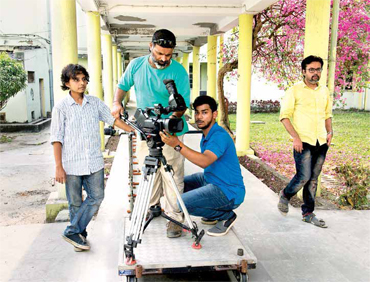
And holding vigil through the varied transitions in its curriculum is Ms Debamitra Mitra, Director, Satyajit Ray Film and Television Institute (SRFTI), Kolkata. Armed with an M. Phil. and PhD. in Social Science, the past 26 years has seen Ms. Mitra’s skills reflect across the domains of social science and media—into academia, research and administration and in audio-visual digital media. She has authored three books, edited 15 books and written more than 70 research papers. Author of End Of Communist Rule in East Europe: Poland, a case study(1993), Indo-Bhutan Relations: Political Process, Conflict and Crisis (2010) and Monograph on India, China and Himalayan Buffers (2016), she believes that nobody can put a ‘perimeter’ on anyone’s creativity. Yet, creativity needs to be nurtured within the framework of technology, politics and the prevailing social structure.
“I believe that whether it is technology or the realm of virtual reality, originality should be maintained by whomsoever and in whichever domain they work; it must come up with an original thought and exemplify originality of the student or the person creating that work. ...The original thought should reflect in the film or other creative medium and automatically it (the creative) will be something different from that of the others...,” says Debamitra Mitra, in this special interview for Corporate Citizen.
 Memoriam
- Legendary
Satyajit Ray
Memoriam
- Legendary
Satyajit RayDebamitra Mitra: Students at SRFTI have both national and international exposure because we teach students the technology and the know-how that impart knowledge not only in filmmaking but also on the skills expected in the television industry and within the scope of electronic digital media (EDM). The curriculum is completely technology-driven where students are trained by facilitating them with the latest and the state -of-the-art equipment, be it the ALEXA camera platform or the Sony F55. Our students use the latest equipment and technology for their projects including short films or their diploma (dissertation) films. Because the entire course is on filmmaking, students are constantly occupied with hands-on project work.
In more ways than one, as SRFTI is a member and affiliated to CAPA and CILECT - The International Association of Film and Television Schools, which is an esteemed global network of major film and television schools. We also connect via the innumerable films made by our students which gain entry at different international film festivals and through the varied awards won by them across diverse platforms. Within the given academic framework, SRFTI has had collaborations and student exchange programmes with the Beijing Film Academy and ZeLIG School for Documentary, Television and New Media, Italy. We are also close to signing MoUs with Dhaka University and Sri Lanka University including a few other international MoUs that are in the pipeline.
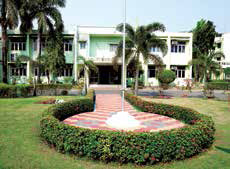 Approach to SRFTI Main Building
Approach to SRFTI Main BuildingSRFTI was primarily conceived to tap and cater to the students of Eastern and Northeast India. Apart from trying to bridge or cover their respective geographical boundaries, there are some variations to the curriculum offered at FTII and SRFTI.
While FTII runs its one-year TV Certification course, SRFTI runs a full-fledged, 2-year, full-time postgraduation (PG) diploma course for electronic and digital media (EDM). Our EDM department which started in 2017 has a scope that is beyond the realm of TV alone. EDM covers six specialisations: cinematography for television, sound design, editing, producing for TV, TV management and writing. Our EDM compares with FTII’s TV stream. While both the institutions offer common courses through their respective departments in the disciplines of direction and screenplay writing, cinematography, editing, sound design and engineering, SRFTI imparts two more specialisations within its Filmmaking wing—animation cinema and producing for films and television. Direction, sound, editing and cinematography are more or less the same in both the institutions. At SRFTI, the departments for filmmaking and EDM have different sets of teachers.
We started many short-term courses since August 2017. This academic year, we conducted four short-term courses and in 2018-19, we plan to do the same and add a few more certificate courses. Earlier, SRFTI didn’t have courses like acting, library automation, film appreciation, non-linear editing which we now advertise and run for either a month, three months or sixmonthly durations. The candidates are either PG students or those from the industry who are seeking certification or aiming to gain in-depth knowledge in a particular stream. Even fresh graduates who are keen on filmmaking but could not make the cut at the entrance tests opt for these courses. The courses are aligned to the industry, but in short capsule formats.
Changes in technology, equipment and the transition from celluloid to digital platform has resulted in regular reviewing of our curriculum. The industry too has evolved both for film-making and EDM; therefore our syllabus has been evolving to meet the changing demands of the industry. While minor course changes are an ongoing process, we did have a major syllabus overhaul in 2008-09. It was the phase when we witnessed a huge shift from the ‘celluloid’ medium to the digital platform. We do undergo smaller revisions each year to keep pace with new technology. With new technological know-how, new equipment and orientations, transitioning so fast, we do have to take on these minor changes. But, the academic changes that we adapt have to be first approved by our Academic Council. The academic body at SRFTI ropes in reputed academicians in the fields of filmmaking and electronic and digital media, pan-India, and form the Academic Council. Yearly, we organise three to four academic council meetings to keep our curriculum relevant. Our Governing Council members are nominated by the I&B Ministry and meet at least three to four times in a year.
The changes are based on parameters which are put before the Academic Council. Once approved, these revisions are then passed on to the Governing Council, after which the changes or revisions made are placed before the I&B ministry for their information and in some cases for further approval.
I had proposed and applied for an affiliation to the Visva-Bharati University with the aim to get the three-year PG diploma course in Filmmaking and two-year PG diploma course in EDM converted into the PG degree programme. However, I have not heard much on this front which also needs to be approved by the Ministry of HRD and the UGC. Once our diploma programmes get upgraded to degree, students will benefit with more job opportunities and opportunities for higher studies and most important, we can concentrate on research and introduce M Phil and PhD programmes.
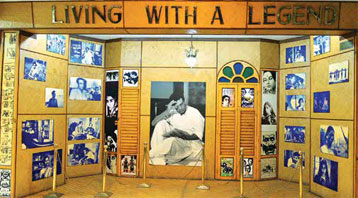 Wall of Memories
Wall of MemoriesFilmmaking does not follow a 10 to 5 job routine. Anybody with adequate knowledge and technological orientation can become a filmmaker. However, filmmaking is shaped by personal passion. Hence it will never lose its relevance. Historically, with the advent of FTII and the launch of SRFTI, filmmaking and TV production have become very well-defined, identified and sought-after discipline for study, research and career. These academies have institutionalised the passion for filmmaking and TV production as academic disciplines for study.
I assumed office end-January 2017 and since then, we have had many things happening on the course and its applications within SRFTI. I started the EDM wing in August 2017 as a separate department with six specialisations. We started our short-term certificate courses in Arunachal Pradesh and in the SRFTI campus. We also commenced making films for other organisations. These organisations are now commissioning their films through us. Our first commissioned assignment has been a film for Kolkata Traffic Police under their ‘Safe Drive Save Life’ campaign which ranked first in Kolkata. We commissioned a documentary film for the S. N. Bose Institute of Basic Science commemorating the 150th year of the renowned scientist Satyen Bose in January 2018. We made the audio-video outputs for them to mark their commemorative year. We also created an audio-video output for the CAG (Kolkata office) to commemorate their 50th year. A fulllength feature film on ‘Swachh Bharat’ is also in the pipeline to be funded by Bindeshwar Pathak, the architect of the pan-India Sulabh International.
“Changes in technology, equipment and the transition from celluloid to digital platform has resulted in regular reviewing of our curriculum. The industry too has evolved both for filmmaking and EDM (electronic digital medium), therefore our syllabus has been evolving to meet the changing demands of the industry. While minor course changes are an ongoing process, we did have a major syllabus overhaul in 2008-09”
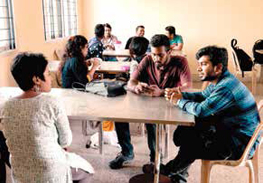 Students chilling out
Students chilling outWe are working towards starting an extension of our SRFTI campus that will eventually house a permanent campus in Arunachal Pradesh. While the funding is being backed by the I&B ministry, the set-up will be mentored by us. The idea is to offer a three-year Undergraduate (UG) course and to bring in this awareness, we have already started the short term (temporary) certificate course at Itanagar since May 2017. The UG programme will be launched once the building for the permanent campus comes up at Jote in Arunachal Pradesh.
I always wanted the dissertation/diploma film made by our final year students to imply real-life scenarios in ‘real’ locations. Since 2017-18 sessions, we have been able to fulfil this by allocating funds and allowing our final year (current 12th batch students) who at the end of their 3rd year would create their dissertation films as commissioned. We pay them a budget of Rs.13 lakh per project wherein they can execute their final diploma film from any of the 10 projects sanctioned annually. They execute by forming collaborative teams as per their specialisations. My vision is for making these films more original with the students actually getting the essence of filmmaking in the ‘primary’ zones, thereby encouraging regional films, regional languages and ethnicity. However, for most of the other projects they do resort to re-created scenes.
 SRFTI Creative Corner
SRFTI Creative CornerAll along, FTII and SRFTI conducted their own admission tests and selection processes individually. However, this limited the capacity of the two institutions in capturing the vast milieu of students nationwide. With the new joint entrance system, we are allowing more students to participate in the courses by enabling more candidates to appear for the selection process. The JET was conducted for the first time in February 2018 that resulted in high numbers of applicants—increasing it three times over that of last year’s. For 2018-19, there are 3,500 applicants for SRFTI courses as opposed to 1,200 applicants last year. The number of exam centres too doubled. This year J&K too had its own exam centre.
Currently, we have 10 national students for each of the six specialisations in Filmmaking which sums up to 60 per batch in a year. We also enrol two foreign students for each of the specialisations who come to us via sponsorship from the Indian Council of Cultural Relations (ICCR). Including foreign-nationality students, we currently cater to a batch of 72 students annually. We started our EDM wing, inclusive of TV course in 2017 which also comprises six specialisations. Since it’s a fairly new course, we do not as yet have designated seats for foreign students and currently cater to only five seats for each of the six specialities - summing up to 30 students. For the 2018-2019 sessions, while we hope to maintain the same number of seats for our Filmmaking department, we might consider increasing seats for EDM, which is open to discussion. However, increasing the student strength randomly is not an easy task, as the curriculum is based on collaborative teamwork. Therefore, we have to do our calculations and reason out the need to increase seats or not!
“Earlier, SRFTI didn’t have courses like ac ting, library automation, film appreciation, non-linear editing which we now advertise for and run for either a month, three months or six-month durations. The candidates are either PG students or those from the industry who are seeking certification or aiming to gain in-depth knowledge in a particular stream. Even fresh graduates who are keen on filmmaking but could not make the cut at the entrance tests opt for these courses. The courses are aligned to the industry but are in short capsule formats”
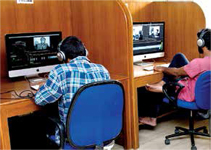 Students editing videos
Students editing videosInitially, they might find it difficult, but the course is such that they intermingle during the first two semesters where the curriculum is integrated and that helps them. It is during this phase that they understand the nuances of having joined SRFTI. With 80% residential students, their well-being is foremost. We do have students from rural backgrounds and extreme remote areas too and one way to integrate them was to incorporate a short-period English teacher for enhancing their vocabulary and speaking skills. We have also engaged a psychologist and a yoga teacher on board along with the existing in-house doctor. Filmmaking institutes work around high-strung creative spaces and these students thus differ from those in regular academic courses. A psychologist can help them to analyse things for themselves, especially for our residential students.
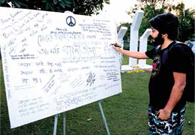 SRFTI’S Linguistic Creativity -
Bhasha Divas
SRFTI’S Linguistic Creativity -
Bhasha DivasOur brilliant alumni not only conduct workshops but also practical classes and mentor students on scripts/lens shooting, etc. Besides, they are instrumental in bringing in professionals from the industry to engage with our students via workshops. They themselves are highly reputed and SRFTI too sets aside funds for conducting such professionally-driven workshops. We make our own budget for this and the departments allocate their budget for the year. For instance, the cinematography department is constantly working with projects involving many people; the budget for which can run to as high as Rs.70 lakh. Therefore, budgetary discretion is based on the purpose to be fulfilled by the respective departments.
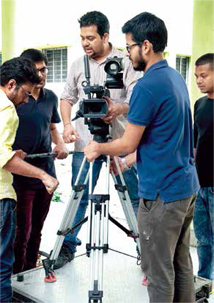 Class in progress
Class in progressSRFTI is very fortunate that the Ministry gives us full aid and we receive 100% grants from the I&B Ministry. Parameters are based on either entrance test results, other test scores and varied other components. Accordingly, we base these guidelines along with marks and attendance and compute it on a case basis. We also get endowments from private entities and corporates.
It is important to understand that filmmaking and TV production have creative dimensions and placements can’t be compared to the kind we see for other MBA or Mass Com graduates. It is a field where everyone works with their own passion. Not everybody is interested in getting mere jobs. A panel of alumni also conduct pitching sessions for students. Letters are posted to SRFTI and the alumni and reputed filmmakers do come on campus and choose from SRFTI’s aspiring talent pool. While some are interested in making their own films, others aspire to be editors or film directors. Some students do get jobs with NFDC, Films Division and the like, but most of them are occupied in their domains within Bollywood or allied film industries as scriptwriters, directors or editors, or cinematographers. Also, by engaging with eminent people who conduct various workshops at the campus, our students are constantly interacting and many get the opportunity to work with them.
 We might consider increasing seats for EDM
We might consider increasing seats for EDMI strongly aspire to launch a full-fledged research wing in SRFTI to fill in the gap where none of the universities are conducting any form of institutionalised research in the disciplines of filmmaking, EDM and/or TV production. Also, there is a lack in understanding that filmmaking and EDM can be recognised as stand-alone and distinct disciplines for absolute career progression for aspiring students. My thought is to initiate some form of research on each of these two domains because right now India lacks any research-based approach and I would like to introduce it. It is one of the reasons that I have urged for the diploma courses to be upgraded to degree programmes in the future. If achieved, interested students could complete their research and possibly earn their respective M. Phil or PhDs. I would also like to see the EDM department growing in leaps and bounds with huge numbers of students studying different specialisations; and maybe we could also get 12 foreign students per wing in the future.
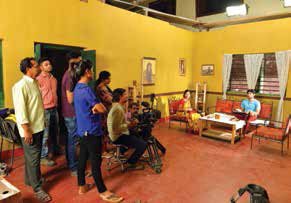 Students - hands-on SET creation
Students - hands-on SET creationI am supportive of giving in-service training to television personalities from our neighbouring countries in South and Southeast Asia since we are the best in infrastructure, technology and other facilities. I am also aiming at outreach programmes especially with the Afro-Asian countries where we can share our expertise with such countries either by imparting filmmaking and television production courses for them or facilitating them for making film schools in their countries and formulating their courses and curriculum.
SRFTI has a large repository of books and resources and our own students’ films which we are looking to digitise. Personally, my thought is to build an archive as part of a heritage mission by bringing together all the exemplary works, thoughts and audio tracks of legendary filmmakers—Satyajit Ray, Ritwick Ghatak et al. We also have other archived historical material, old cinematographic equipment and editing machines with antique and historical implications, besides cameras and the related evolved models as exhibits. Perhaps at a later date, we could also think of sharing these priceless exhibits and cinemas to the general public akin to a museum repository. It could serve as an archived exhibition of work of the great legendary creative minds for all!
By Sangeeta Ghosh Dastidar